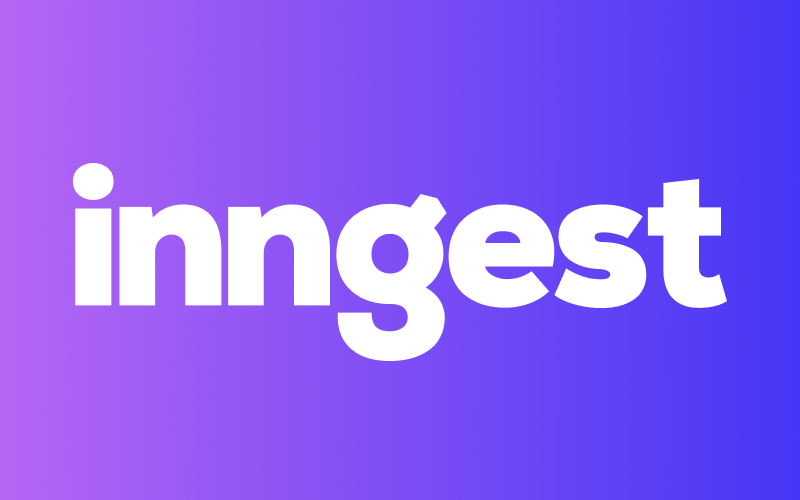
Serverless event-driven queues, background jobs, and scheduled jobs for Typescript.
Works with any framework and platform.
Read the
documentation and get started in minutes.




On any serverless platform (Next.js, Deno Deploy, RedwoodJS, AWS Lambda, and anything else) and with no extra infrastructure:
- ⚡ Write background jobs
- 🕐 Create scheduled & cron jobs
- ♻️ Build serverless queues
- 🪜 Write complex step functions
- 🚘 Build serverless event-driven systems
- 🪝 Reliably respond to webhooks, with retries & payloads stored for history
👋 Have a question or feature request? Join our Discord!
Getting started ·
Features ·
Contributing ·
Documentation
Getting started
Install Inngest:
npm install inngest
Writing functions
Write serverless functions and background jobs right in your own code:
import { Inngest } from "inngest";
const inngest = new Inngest({ name: "My App" });
export default inngest.createFunction(
{ name: "User onboarding communication" },
{ event: "app/user.signup" },
async ({ event, step }) => {
await step.run("Send welcome email", async () => {
await sendEmail({
email: event.data.email,
template: "welcome",
});
});
}
);
- Functions are triggered by events which can be sent via this SDK, webhooks, integrations, or with a simple HTTP request.
- When a matching event is received, Inngest invokes the function automatically, with built-in retries.
Serving your functions
Inngest invokes functions via HTTP, so you need to serve them using an adapter for the framework of your choice. See all frameworks here in our docs. Here is an example using the Next.js serve handler:
import { Inngest } from "inngest";
import { serve } from "inngest/next";
import myFunction from "../userOnboardingCOmmunication";
const inngest = new Inngest({ name: "My App" });
export default serve(inngest, [myFunction]);
Sending events to trigger functions
import { Inngest } from "inngest";
const inngest = new Inngest({ name: "My App" });
inngest.send("app/user.signup", {
data: { email: "text@example.com", user_id: "12345" },
});
- Events can trigger one or more functions automatically, enabling you to fan-out work.
- Inngest stores a history of all events for observability, testing, and replay.
Features
- Fully serverless: Run background jobs, scheduled functions, and build event-driven systems without any servers, state, or setup
- Works with your framework: Works with Next.js, Redwood, Express, Cloudflare Pages, Nuxt, Fresh (Deno), and Remix
- Deploy anywhere: Keep deploying to your existing platform: Vercel, Netlify, Cloudflare, Deno, Digital Ocean, etc.
- Use your existing code: Write functions within your current project and repo
- Fully typed: Event schemas, versioning, and governance out of the box
- Observable: A full UI for managing and inspecting your functions
Contributing
Prerequisites:
- Clone this repository
- Intall
pnpm - Install Volta to manage consistent Node versions (optional)
Development
Run the following command in the packages/inngest/ directory:
pnpm dev
This will install dependencies, build, and lint the package. It will watch for changes and re-run appropriate commands.
Testing the package
To test changes with other local repositories, we recommend packaging the library entirely and directly installing the resulting .tgz file. This is often more reliable than linking, which can cause issues when using multiple package managers.
pnpm local:pack
yarn add ~/path/to/packages/inngest/inngest.tgz
You can also use this method to ship a snapshot of the library with an application. This is a nice way to generate and ship snapshot versions without requiring a release to npm.
Releasing
To release to production, we use Changesets. This means that releasing and changelog generation is all managed through PRs, where a bot will guide you through the process of adding release notes to PRs.
As PRs are merged into main, a new PR (usually called Release @latest) is created that rolls up all release notes since the last release, allowing you bundle changes together. Once you're happy with the release, merge this new PR and the bot will release the package to npm for you.
Merging PRs to main (therefore both introducing a potential change and releasing to npm) requires that tests pass and a contributor has approved the PR.
Legacy versions
Merging and releasing to previous major versions of the SDK is also supported.
- Add a
backport v*.x label (e.g. backport v1.x) to a PR to have a backport PR generated when the initial PR is merged. - Merging into a
v*.x branch creates a release PR (named Release v1.x, for example) the same as the main branch. Simply merge to release.
Snapshot versions
If a local inngest.tgz isn't ideal, we can release a tagged version to npm. For now, this is relatively manual. For this, please ensure you are in an open PR branch for observability.
Decide on the "tag" you will be publishing to, which will dictate how the user installs the snapshot, e.g. if your tag is beta, the user will install using inngest@beta.
You can see the currently available tags on the inngest npm page.
NEVER use the latest tag, and NEVER run npm publish without specifying --tag.
If the current active version is v1.1.1, this is a minor release, and our tag is foo, we'd do:
yarn version 1.2.0-foo.1
yarn build
npm publish --access public --tag foo
You can iterate the final number for each extra snapshot you need to do on a branch.








